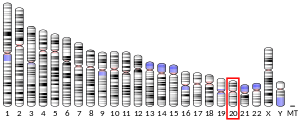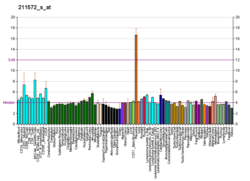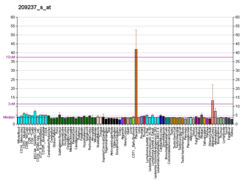SLC23A2
Solute carrier family 23 member 2 is a protein that in humans is encoded by the SLC23A2 gene.[5][6][7]
The absorption of vitamin C into the body and its distribution to organs requires two sodium-dependent vitamin C transporters. This gene encodes one of the two required transporters and the encoded protein accounts for tissue-specific uptake of vitamin C. Previously, this gene had an official symbol of SLC23A1.[7]
See also
References
- GRCh38: Ensembl release 89: ENSG00000089057 - Ensembl, May 2017
- GRCm38: Ensembl release 89: ENSMUSG00000027340 - Ensembl, May 2017
- "Human PubMed Reference:". National Center for Biotechnology Information, U.S. National Library of Medicine.
- "Mouse PubMed Reference:". National Center for Biotechnology Information, U.S. National Library of Medicine.
- Faaland CA, Race JE, Ricken G, Warner FJ, Williams WJ, Holtzman EJ (Dec 1998). "Molecular characterization of two novel transporters from human and mouse kidney and from LLC-PK1 cells reveals a novel conserved family that is homologous to bacterial and Aspergillus nucleobase transporters". Biochim Biophys Acta. 1442 (2–3): 353–60. doi:10.1016/S0167-4781(98)00151-1. PMID 9804989.
- Tsukaguchi H, Tokui T, Mackenzie B, Berger UV, Chen XZ, Wang Y, Brubaker RF, Hediger MA (Jun 1999). "A family of mammalian Na+-dependent L-ascorbic acid transporters". Nature. 399 (6731): 70–5. doi:10.1038/19986. PMID 10331392.
- "Entrez Gene: SLC23A2 solute carrier family 23 (nucleobase transporters), member 2".
Further reading
- Liang WJ, Johnson D, Jarvis SM (2001). "Vitamin C transport systems of mammalian cells". Mol. Membr. Biol. 18 (1): 87–95. doi:10.1080/09687680110033774. PMID 11396616.
- Nakajima D, Okazaki N, Yamakawa H, et al. (2003). "Construction of expression-ready cDNA clones for KIAA genes: manual curation of 330 KIAA cDNA clones". DNA Res. 9 (3): 99–106. doi:10.1093/dnares/9.3.99. PMID 12168954.
- Nagase T, Seki N, Ishikawa K, et al. (1997). "Prediction of the coding sequences of unidentified human genes. VI. The coding sequences of 80 new genes (KIAA0201-KIAA0280) deduced by analysis of cDNA clones from cell line KG-1 and brain". DNA Res. 3 (5): 321–9, 341–54. doi:10.1093/dnares/3.5.321. PMID 9039502.
- Hogue DL, Ling V (1999). "A human nucleobase transporter-like cDNA (SLC23A1): member of a transporter family conserved from bacteria to mammals". Genomics. 59 (1): 18–23. doi:10.1006/geno.1999.5847. PMID 10395795.
- Rajan DP, Huang W, Dutta B, et al. (1999). "Human placental sodium-dependent vitamin C transporter (SVCT2): molecular cloning and transport function". Biochem. Biophys. Res. Commun. 262 (3): 762–8. doi:10.1006/bbrc.1999.1272. PMID 10471399.
- Daruwala R, Song J, Koh WS, et al. (1999). "Cloning and functional characterization of the human sodium-dependent vitamin C transporters hSVCT1 and hSVCT2". FEBS Lett. 460 (3): 480–4. doi:10.1016/S0014-5793(99)01393-9. PMID 10556521.
- Breton S, Wiederhold T, Marshansky V, et al. (2000). "The B1 subunit of the H+ATPase is a PDZ domain-binding protein. Colocalization with NHE-RF in renal B-intercalated cells". J. Biol. Chem. 275 (24): 18219–24. doi:10.1074/jbc.M909857199. PMID 10748165.
- Holliday LS, Lu M, Lee BS, et al. (2000). "The amino-terminal domain of the B subunit of vacuolar H+-ATPase contains a filamentous actin binding site". J. Biol. Chem. 275 (41): 32331–7. doi:10.1074/jbc.M004795200. PMID 10915794.
- Deloukas P, Matthews LH, Ashurst J, et al. (2002). "The DNA sequence and comparative analysis of human chromosome 20". Nature. 414 (6866): 865–71. doi:10.1038/414865a. PMID 11780052.
- Hediger MA (2002). "New view at C.". Nat. Med. 8 (5): 445–6. doi:10.1038/nm0502-445. PMID 11984580.
- Strausberg RL, Feingold EA, Grouse LH, et al. (2003). "Generation and initial analysis of more than 15,000 full-length human and mouse cDNA sequences". Proc. Natl. Acad. Sci. U.S.A. 99 (26): 16899–903. doi:10.1073/pnas.242603899. PMC 139241. PMID 12477932.
- Fischer H, Schwarzer C, Illek B (2004). "Vitamin C controls the cystic fibrosis transmembrane conductance regulator chloride channel". Proc. Natl. Acad. Sci. U.S.A. 101 (10): 3691–6. doi:10.1073/pnas.0308393100. PMC 373524. PMID 14993613.
- Lutsenko EA, Carcamo JM, Golde DW (2004). "A human sodium-dependent vitamin C transporter 2 isoform acts as a dominant-negative inhibitor of ascorbic acid transport". Mol. Cell. Biol. 24 (8): 3150–6. doi:10.1128/MCB.24.8.3150-3156.2004. PMC 381605. PMID 15060139.
- Seno T, Inoue N, Matsui K, et al. (2004). "Functional expression of sodium-dependent vitamin C transporter 2 in human endothelial cells". J. Vasc. Res. 41 (4): 345–51. doi:10.1159/000080525. PMID 15340249.
- Gerhard DS, Wagner L, Feingold EA, et al. (2004). "The status, quality, and expansion of the NIH full-length cDNA project: the Mammalian Gene Collection (MGC)". Genome Res. 14 (10B): 2121–7. doi:10.1101/gr.2596504. PMC 528928. PMID 15489334.
- McNulty AL, Vail TP, Kraus VB (2005). "Chondrocyte transport and concentration of ascorbic acid is mediated by SVCT2". Biochim. Biophys. Acta. 1712 (2): 212–21. doi:10.1016/j.bbamem.2005.04.009. PMID 15921655.
This article incorporates text from the United States National Library of Medicine, which is in the public domain.
This article is issued from Wikipedia. The text is licensed under Creative Commons - Attribution - Sharealike. Additional terms may apply for the media files.






